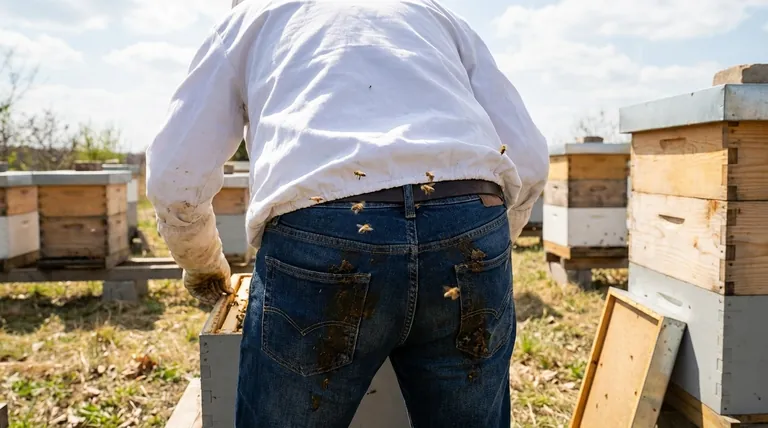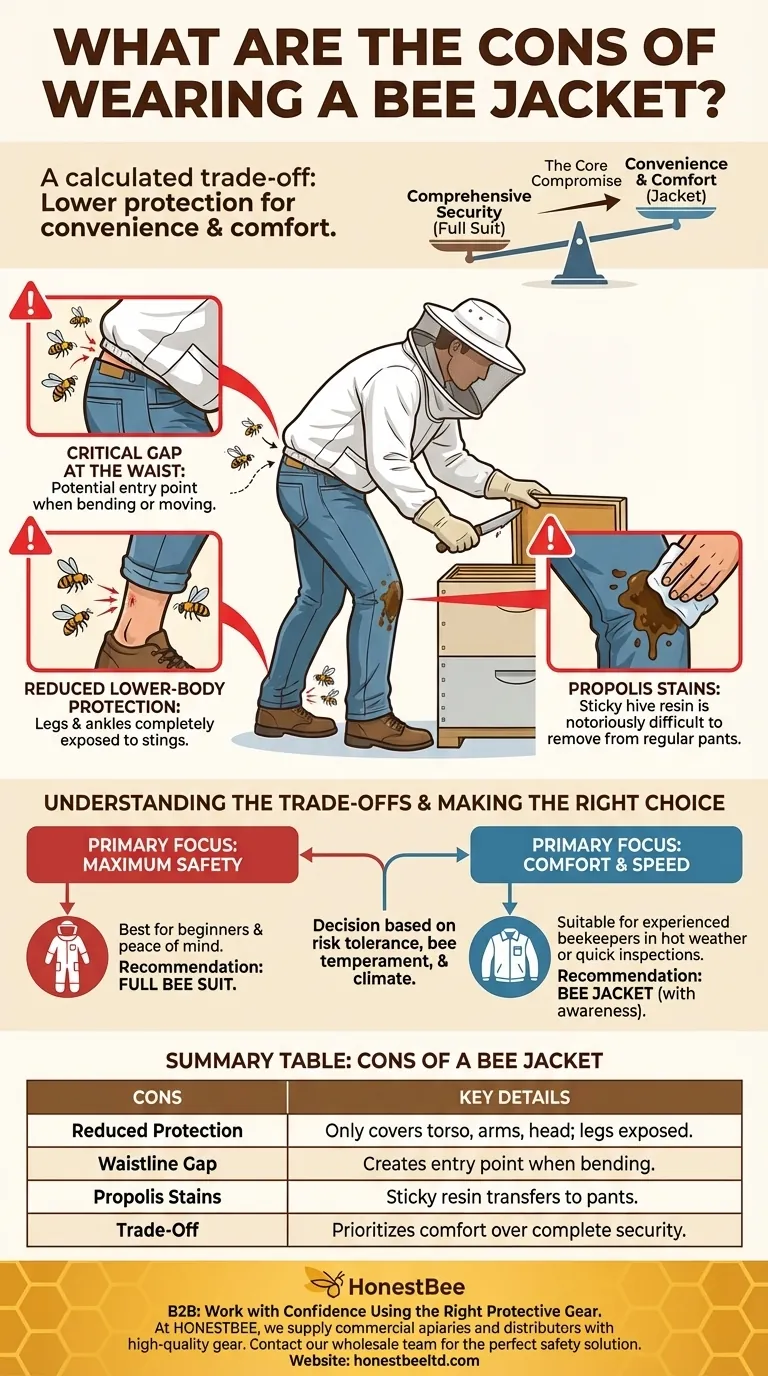The primary disadvantages of a bee jacket are that it offers significantly less protection than a full suit, creates a potential entry point for bees at the waistline, and can lead to propolis stains on your regular pants. This choice in protective gear fundamentally trades comprehensive security for convenience and comfort.
A bee jacket represents a calculated trade-off. While it provides essential upper-body protection and is cooler and easier to wear, it compromises on the complete, sealed security that a full bee suit offers.

The Core Compromise: Protection vs. Convenience
Choosing between a bee jacket and a full suit is one of the first critical safety decisions a beekeeper makes. Understanding the jacket's specific vulnerabilities is essential to making an informed choice.
Reduced Lower-Body Protection
A bee jacket, by design, only covers your torso, arms, and head. This leaves your legs and ankles completely exposed to potential stings.
While you will wear pants, standard clothing like jeans offers minimal protection against a determined bee's stinger.
The Critical Gap at the Waist
The most significant structural weakness of a jacket is the separation between the jacket and your pants.
When you bend, lift, or move, a gap can easily open up around your waist. This creates a clear entry point for bees to get inside your protective gear, which can be a distressing and dangerous situation.
The Propolis Problem
Bees use a sticky, resinous substance called propolis to seal cracks in the hive. It is an unavoidable part of hive inspections.
When wearing a jacket, you will inevitably get propolis on your jeans or pants. This substance is notoriously difficult to remove from clothing.
Understanding the Trade-offs
While the protective cons are significant, bee jackets remain popular for valid reasons. Their advantages center on comfort and ease of use, which become more important with experience and in certain climates.
Benefit: Increased Comfort and Airflow
On a hot day, a full bee suit can become extremely warm and cumbersome. A jacket allows for much better ventilation around the lower body, making hive work more tolerable.
Benefit: Ease of Use
A jacket is far quicker to put on and take off than a full suit. This convenience is a major advantage for beekeepers performing quick, routine inspections.
Benefit: Lower Cost
Bee jackets are generally less expensive than full, one-piece bee suits. This can make them an attractive option for new beekeepers who are managing initial equipment costs.
Making the Right Choice for Your Situation
Your decision should be based on your personal risk tolerance, the temperament of your bees, and the climate you work in.
- If your primary focus is maximum safety and peace of mind: A full bee suit is the superior choice, especially for beginners who are still building confidence.
- If your primary focus is comfort during quick inspections in hot weather: A jacket can be a suitable option for experienced beekeepers who are comfortable with the reduced protection.
- If your primary focus is minimizing costs: A jacket is a more budget-friendly entry point, but you must be constantly aware of its inherent vulnerabilities at the waist and lower body.
Ultimately, the best protective gear is the one that allows you to work calmly and confidently with your bees.
Summary Table:
| Cons of a Bee Jacket | Key Details |
|---|---|
| Reduced Protection | Only covers torso, arms, and head; legs and ankles are exposed. |
| Waistline Gap | Creates a potential entry point for bees when bending or moving. |
| Propolis Stains | Sticky hive resin can easily transfer to and stain your regular pants. |
| Trade-Off | Prioritizes comfort and convenience over the complete security of a full suit. |
Work with Confidence Using the Right Protective Gear
Choosing the correct equipment is fundamental to safe and effective beekeeping. At HONESTBEE, we supply commercial apiaries and beekeeping equipment distributors with high-quality, durable protective gear through our wholesale-focused operations. Whether your priority is the maximum security of a full bee suit or the ventilated comfort of a jacket, we provide the reliable equipment you need to protect your team and manage your hives with confidence.
Let's discuss your apiary's specific needs. Contact our wholesale team today to find the perfect safety solution.
Visual Guide

Related Products
- Cotton Beekeeping Suit and Round Hat with Veil Bee Keeper Protective Gear
- Economy Polyester Beekeeping Jacket with Veil and Hat
- Beekeeping Jacket with Hood and Veil for Beekeepers
- White Beekeeping Protective Suit and Hat with Fencing Veil for Beekeepers
- Professional Beekeeping Suit for Kids and Girls Childrens Bee Keeper Suit
People Also Ask
- What are the benefits of a fully ventilated beekeeping suit? Stay Cool and Protected in Hot Climates
- What should be considered regarding the color of beekeeping clothing? Ensure Your Safety and Keep Bees Calm
- Why is a jacket with a hat veil recommended for beekeepers? Essential Protection for Your Face and Neck
- What are bee suits made of? Choosing the Right Material for Maximum Protection & Comfort
- How should a beekeeping suit be hung to maintain its shape? Protect Your Investment with Proper Storage



















